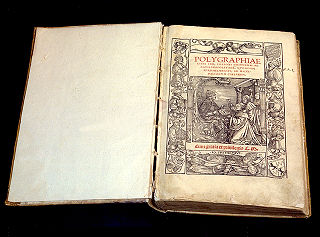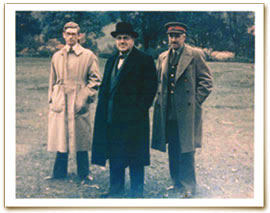
Cryptanalysis refers to the process of analyzing information systems in order to understand hidden aspects of the systems. Cryptanalysis is used to breach cryptographic security systems and gain access to the contents of encrypted messages, even if the cryptographic key is unknown.

In the history of cryptography, the "System 97 Typewriter for European Characters" or "Type B Cipher Machine", codenamed Purple by the United States, was an encryption machine used by the Japanese Foreign Office from February 1939 to the end of World War II. The machine was an electromechanical device that used stepping-switches to encrypt the most sensitive diplomatic traffic. All messages were written in the 26-letter English alphabet, which was commonly used for telegraphy. Any Japanese text had to be transliterated or coded. The 26-letters were separated using a plug board into two groups, of six and twenty letters respectively. The letters in the sixes group were scrambled using a 6 × 25 substitution table, while letters in the twenties group were more thoroughly scrambled using three successive 20 × 25 substitution tables.

William Frederick Friedman was a US Army cryptographer who ran the research division of the Army's Signal Intelligence Service (SIS) in the 1930s, and parts of its follow-on services into the 1950s. In 1940, subordinates of his led by Frank Rowlett broke Japan's PURPLE cipher, thus disclosing Japanese diplomatic secrets before America's entrance into World War II.
The vulnerability of Japanese naval codes and ciphers was crucial to the conduct of World War II, and had an important influence on foreign relations between Japan and the west in the years leading up to the war as well. Every Japanese code was eventually broken, and the intelligence gathered made possible such operations as the victorious American ambush of the Japanese Navy at Midway in 1942 and the shooting down of Japanese admiral Isoroku Yamamoto a year later in Operation Vengeance.

Books on cryptography have been published sporadically and with highly variable quality for a long time. This is despite the tempting, though superficial, paradox that secrecy is of the essence in sending confidential messages – see Kerckhoffs' principle.

Elizebeth Smith Friedman was an American cryptanalyst and author who deciphered enemy codes in both World Wars and helped to solve international smuggling cases during Prohibition. Over the course of her career, she worked for the United States Treasury, Coast Guard, Navy and Army, and the International Monetary Fund. She has been called "America's first female cryptanalyst".

Herbert Osborn Yardley was an American cryptologist. He founded and led the cryptographic organization the Black Chamber. Under Yardley, the cryptanalysts of The American Black Chamber broke Japanese diplomatic codes and were able to furnish American negotiators with significant information during the Washington Naval Conference of 1921–1922. Recipient of the Distinguished Service Medal. He wrote The American Black Chamber (1931) about his experiences there. He later helped the Nationalists in China (1938–1940) to break Japanese codes. Following his work in China, Yardley worked briefly for the Canadian government, helping it set up a cryptological section of the National Research Council of Canada from June to December 1941. Yardley was reportedly let go due to pressure either from the Secretary of War Henry L. Stimson or from the British.

Joseph John Rochefort was an American naval officer and cryptanalyst. He was a major figure in the United States Navy's cryptographic and intelligence operations from 1925 to 1946, particularly in the Battle of Midway. His contributions and those of his team were pivotal to victory in the Pacific War.

Agnes Meyer Driscoll, known as "Miss Aggie" or "Madame X'", was an American cryptanalyst during both World War I and World War II and was known as "the first lady of naval cryptology."

Brigadier John Hessell Tiltman, was a British Army officer who worked in intelligence, often at or with the Government Code and Cypher School (GC&CS) starting in the 1920s. His intelligence work was largely connected with cryptography, and he showed exceptional skill at cryptanalysis. His work in association with Bill Tutte on the cryptanalysis of the Lorenz cipher, the German teleprinter cipher, called "Tunny" at Bletchley Park, led to breakthroughs in attack methods on the code, without a computer. It was to exploit those methods, at extremely high speed with great reliability, that Colossus, the first digital programmable electronic computer, was designed and built.

The National Cryptologic Museum (NCM) is an American museum of cryptologic history that is affiliated with the National Security Agency (NSA). The first public museum in the U.S. Intelligence Community, NCM is located in the former Colony Seven Motel, just two blocks from the NSA headquarters at Fort George G. Meade in Maryland. The motel was purchased, creating a buffer zone between the high security main buildings of the NSA and an adjacent highway. The museum opened to the public on December 16, 1993, and now hosts about 50,000 visitors annually from all over the world.
Cryptography was used extensively during World War II because of the importance of radio communication and the ease of radio interception. The nations involved fielded a plethora of code and cipher systems, many of the latter using rotor machines. As a result, the theoretical and practical aspects of cryptanalysis, or codebreaking, were much advanced.
The National Security Agency took over responsibility for all US government encryption systems when it was formed in 1952. The technical details of most NSA-approved systems are still classified, but much more about its early systems have become known and its most modern systems share at least some features with commercial products.

This glossary lists types of keys as the term is used in cryptography, as opposed to door locks. Terms that are primarily used by the U.S. National Security Agency are marked (NSA). For classification of keys according to their usage see cryptographic key types.
Below is a timeline of notable events related to cryptography.
Station HYPO, also known as Fleet Radio Unit Pacific (FRUPAC), was the United States Navy signals monitoring and cryptographic intelligence unit in Hawaii during World War II. It was one of two major Allied signals intelligence units, called Fleet Radio Units in the Pacific theaters, along with FRUMEL in Melbourne, Australia. The station took its initial name from the phonetic code at the time for "H" for Heʻeia, Hawaii radio tower. The precise importance and role of HYPO in penetrating the Japanese naval codes has been the subject of considerable controversy, reflecting internal tensions amongst US Navy cryptographic stations.
Station CAST was the United States Navy signals monitoring and cryptographic intelligence fleet radio unit at Cavite Navy Yard in the Philippines, until Cavite was captured by the Japanese forces in 1942, during World War II. It was an important part of the Allied intelligence effort, addressing Japanese communications as the War expanded from China into the rest of the Pacific theaters. As Japanese advances in the Philippines threatened CAST, its staff and services were progressively transferred to Corregidor in Manila Bay, and eventually to a newly formed US-Australian station, FRUMEL in Melbourne, Australia.

In the history of cryptography, 91-shiki ōbun injiki or Angōki Taipu-A, codenamed Red by the United States, was a diplomatic cryptographic machine used by the Japanese Foreign Office before and during World War II. A relatively simple device, it was quickly broken by western cryptographers. The Red cipher was succeeded by the Type B "Purple" machine which used some of the same principles. Parallel usage of the two systems assisted in the breaking of the Purple system.
Francis Raven was an American cryptologist and an early employee of the National Security Agency. He helped to crack many codes to assist the United States during World War II. He also helped the NSA's training program by creating two cryptology courses.
The Cipher Department of the High Command of the Wehrmacht was the Signal Intelligence Agency of the Supreme Command of the Armed Forces of the German Armed Forces before and during World War II. OKW/Chi, within the formal order of battle hierarchy OKW/WFsT/Ag WNV/Chi, dealt with the cryptanalysis and deciphering of enemy and neutral states' message traffic and security control of its own key processes and machinery, such as the rotor cipher ENIGMA machine. It was the successor to the former Chi bureau of the Reichswehr Ministry.













